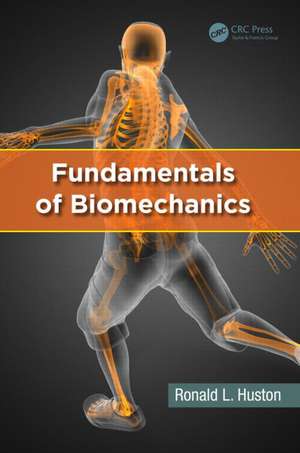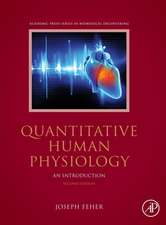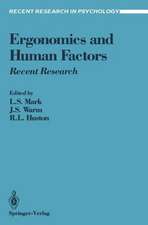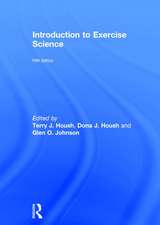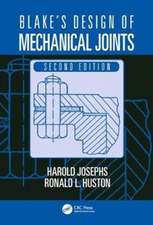Fundamentals of Biomechanics
Autor Ronald L. Hustonen Limba Engleză Hardback – 18 apr 2013
Following a brief introductory chapter, the book reviews gross human anatomy and basic terminology currently in use. It describes methods of analysis from elementary mathematics to elementary mechanics and goes on to fundamental concepts of the mechanics of materials. It then covers the modeling of biosystems and provides a brief overview of tissue biomechanics. The author then introduces the concepts of biodynamics and human body modeling, looking at the fundamentals of the kinematics, the kinetics, and the inertial properties of human body models. He supplies a more detailed analysis of kinematics, kinetics, and dynamics of these models and discusses the numerical procedures for solving the governing dynamical equations. The book concludes with a review of a few example applications of biodynamic models such as simple lifting, maneuvering in space, walking, swimming, and crash victim simulation.
The inclusion of extensive lists of problems of varying difficulty, references, and an extensive bibliography add breadth and depth to the coverage. Focusing on biodynamic modeling to a degree not found in other texts, this book equips readers with the expertise in biomechanics they need for advanced studies, research, and employment in biomedical engineering.
Preț: 801.39 lei
Preț vechi: 977.31 lei
-18% Nou
Puncte Express: 1202
Preț estimativ în valută:
153.35€ • 163.98$ • 127.86£
153.35€ • 163.98$ • 127.86£
Carte tipărită la comandă
Livrare economică 18 aprilie-02 mai
Preluare comenzi: 021 569.72.76
Specificații
ISBN-13: 9781466510371
ISBN-10: 1466510374
Pagini: 470
Ilustrații: 336 b/w images, 100 tables and 1253
Dimensiuni: 178 x 254 x 28 mm
Greutate: 1 kg
Ediția:New.
Editura: CRC Press
Colecția CRC Press
Locul publicării:Boca Raton, United States
ISBN-10: 1466510374
Pagini: 470
Ilustrații: 336 b/w images, 100 tables and 1253
Dimensiuni: 178 x 254 x 28 mm
Greutate: 1 kg
Ediția:New.
Editura: CRC Press
Colecția CRC Press
Locul publicării:Boca Raton, United States
Public țintă
Undergraduate students in biomedical engineering departments and mechanical engineering departments taking an introductory course in biomechanics, graduate students in biomedical engineering and mechanical engineering, and researchers and practitioners in biomechanics and human factors/ergonomics.Cuprins
Introduction. Review of Human Anatomy and Some Basic Terminology. Methods of Analysis I: Review of Vectors, Dyadics, Matrices, and Determinants. Methods of Analysis II: Forces and Force Systems. Methods of Analysis III: Mechanics of Materials. Methods of Analysis IV: Modeling of Biosystems. Tissue Biomechanics. Kinematical Preliminaries: Fundamental Equations. Kinematic Preliminaries: Inertia Force Considerations. Human Body Inertia Properties. Kinematics of Human Body Models. Kinetics of Human Body Models. Dynamics of Human Body Models. Numerical Methods. Simulations and Applications.
Notă biografică
Ronald L. Huston is a Distinguished Research Professor in the School of Dynamic Systems, College of Engineering and Applied Science, at the University of Cincinnati, Ohio.
Recenzii
"This book provides a thorough and easy-to-understand presentation of the fundamentals required to study the mechanics of human motion. I am happy to see an emphasis on the fundamentals of biodynamic modeling and the development of human body models. This should allow readers to more quickly understand and develop models associated with human motion. Huston is a skilled author with the ability to render difficult topics manageable."
—James W. Kamman, Mechanical & Aeronautical Engineering, College of Engineering and Applied Sciences, Western Michigan University
"This biomechanics book does indeed lay the ground for learning the fundamentals in biomechanics, which have been lacking for so many years. The books gets away from the statics concepts that are quite abundant and dominant topics in previous published biomechanics books and instead focuses on motion, dynamics and current and practical problems that are relevant to gait analysis, and human joint dynamics. The examples are vivid, intuitive, interesting and are the product of the author’s rich and exemplary many years of research and teaching."
"Finally a biomechanics book that deals with dynamics of BIOSYSTEMS in depth. The author has 15 chapters, which can be used in away to conform to a number of biomechanics course levels or simply be taught in 2 semesters. The book can be an outstanding tool for those interested in simulation of gait, human joint kinematics, and muscles force identification and modeling in general."
—Farid Amirouche, University of Illinois at Chicago
"A unified method of approach to the analysis of biodynamic system is clearly addressed. This book can be used for senior undergraduate and beginning graduate students to study biomechanics. It can be also used as a reference for automotive engineers and researchers … .
Derivations of equations and formulae in this book were clear and that should be helpful for readers. The various chapters contain problems for readers studying the subject for first time, and for those seeking additional expertise and/or review. Overall I commend the author for writing the text and I trust that it will be a good addition to the university and engineering libraries."
—C. Q. Liu, Chrysler LLC, Troy, Michigan
—James W. Kamman, Mechanical & Aeronautical Engineering, College of Engineering and Applied Sciences, Western Michigan University
"This biomechanics book does indeed lay the ground for learning the fundamentals in biomechanics, which have been lacking for so many years. The books gets away from the statics concepts that are quite abundant and dominant topics in previous published biomechanics books and instead focuses on motion, dynamics and current and practical problems that are relevant to gait analysis, and human joint dynamics. The examples are vivid, intuitive, interesting and are the product of the author’s rich and exemplary many years of research and teaching."
"Finally a biomechanics book that deals with dynamics of BIOSYSTEMS in depth. The author has 15 chapters, which can be used in away to conform to a number of biomechanics course levels or simply be taught in 2 semesters. The book can be an outstanding tool for those interested in simulation of gait, human joint kinematics, and muscles force identification and modeling in general."
—Farid Amirouche, University of Illinois at Chicago
"A unified method of approach to the analysis of biodynamic system is clearly addressed. This book can be used for senior undergraduate and beginning graduate students to study biomechanics. It can be also used as a reference for automotive engineers and researchers … .
Derivations of equations and formulae in this book were clear and that should be helpful for readers. The various chapters contain problems for readers studying the subject for first time, and for those seeking additional expertise and/or review. Overall I commend the author for writing the text and I trust that it will be a good addition to the university and engineering libraries."
—C. Q. Liu, Chrysler LLC, Troy, Michigan
Descriere
This textbook provides a comprehensive survey of how the principles of mechanics are applied to human systems and organs. After a review of terminology, a summary of human anatomy, and a presentation of anthropometric data, the text discusses methods for biomechanical analyses including essential mathematics, mechanics, and modeling techniques. It then covers tissue biomechanics, kinematics, and dynamics of human body models, and applications such as lifting, walking, swimming, and accident victim simulation. Each chapter contains reference lists for more in-depth study and problems sets with solutions.
